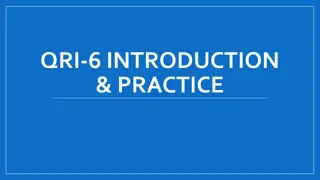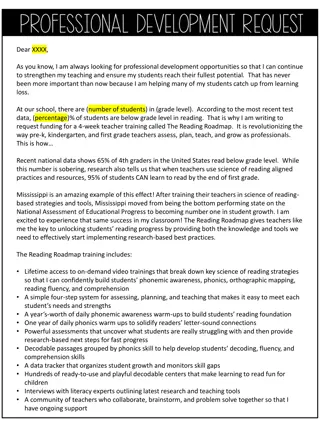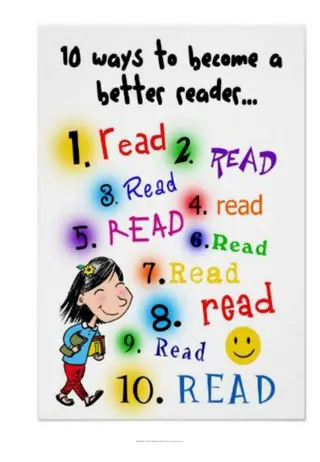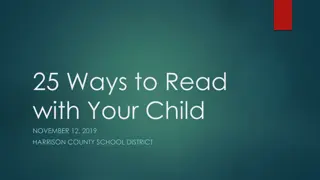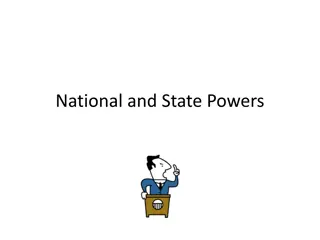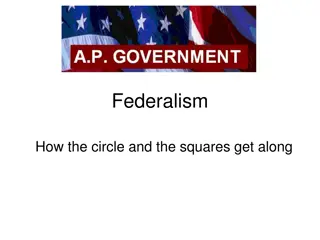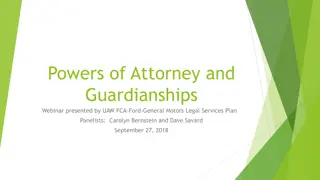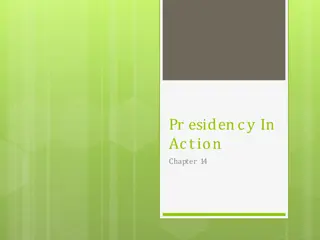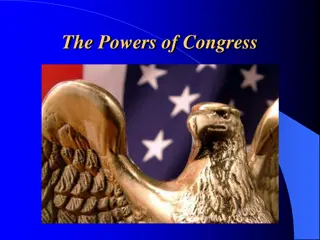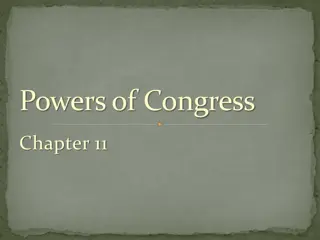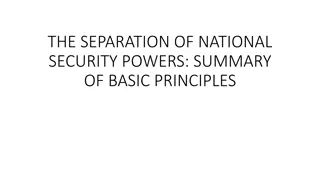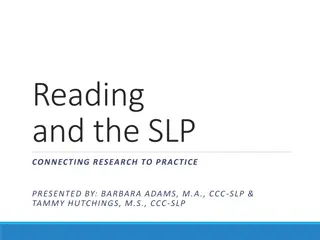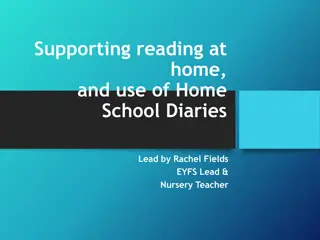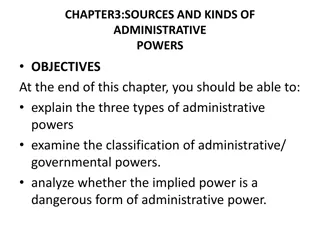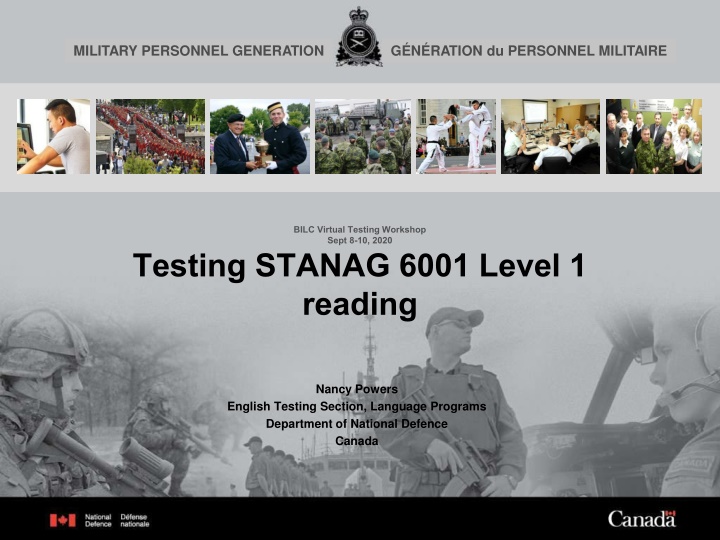
STANAG 6001 Level 1 Reading Skills in Military Personnel Development
Enhance your understanding of STANAG 6001 Level 1 reading proficiency for military personnel through this detailed guide. Explore the characteristics, challenges, and examples of Level 1 reading materials, emphasizing simple connected texts related to survival and workplace scenarios. Improve your ability to comprehend basic texts, identify specific details, and interpret unfamiliar vocabulary effectively.
Download Presentation

Please find below an Image/Link to download the presentation.
The content on the website is provided AS IS for your information and personal use only. It may not be sold, licensed, or shared on other websites without obtaining consent from the author. If you encounter any issues during the download, it is possible that the publisher has removed the file from their server.
You are allowed to download the files provided on this website for personal or commercial use, subject to the condition that they are used lawfully. All files are the property of their respective owners.
The content on the website is provided AS IS for your information and personal use only. It may not be sold, licensed, or shared on other websites without obtaining consent from the author.
E N D
Presentation Transcript
MILITARY PERSONNEL GENERATION G N RATION du PERSONNEL MILITAIRE BILC Virtual Testing Workshop Sept 8-10, 2020 Testing STANAG 6001 Level 1 reading Nancy Powers English Testing Section, Language Programs Department of National Defence Canada 1
Introduction STANAG 6001 Level Descriptors 2
Introduction STANAG 6001 Level Descriptors Characteristics of Level 1 texts 3
Introduction STANAG 6001 Level Descriptors Characteristics of Level 1 texts Challenges of finding Level 1 texts 4
Introduction STANAG 6001 Level Descriptors Characteristics of Level 1 texts Challenges of finding Level 1 texts Examples of Level 1 reading items 5
Level 1 = survival STANAG 6001 = criterion-referenced Content Task Accuracy C/T/A statements 6
Level 1 (survival) Can read very simple connected written material, such as unambiguous texts that are directly related to everyday survival or workplace situations. Texts may include short notes; announcements; highly predictable descriptions of people, places, or things; brief explanations of geography, government, and currency systems simplified for non-natives; short sets of instructions and directions (application forms, maps, menus, directories, brochures, and simple schedules). Understands the basic meaning of simple texts containing high frequency structural patterns and vocabulary, including shared international terms and cognates (when applicable). Can find some specific details through careful or selective reading. Can often guess the meaning of unfamiliar words from simple context. May be able to identify major topics in some higher level texts. However, may misunderstand even some simple texts. 7
Level 1 (content) Can read very simple connected written material, such as unambiguous texts that are directly related to everyday survival or workplace situations. Texts may include short notes; announcements; highly predictable descriptions of people, places, or things; brief explanations of geography, government, and currency systems simplified for non-natives; short sets of instructions and directions (application forms, maps, menus, directories, brochures, and simple schedules). Understands the basic meaning of simple texts containing high frequency structural patterns and vocabulary, including shared international terms and cognates (when applicable). Can find some specific details through careful or selective reading. Can often guess the meaning of unfamiliar words from simple context. May be able to identify major topics in some higher level texts. However, may misunderstand even some simple texts. 8
Level 1 (task) Can read very simple connected written material, such as unambiguous texts that are directly related to everyday survival or workplace situations. Texts may include short notes; announcements; highly predictable descriptions of people, places, or things; brief explanations of geography, government, and currency systems simplified for non-natives; short sets of instructions and directions (application forms, maps, menus, directories, brochures, and simple schedules). Understands the basic meaning of simple texts containing high frequency structural patterns and vocabulary, including shared international terms and cognates (when applicable). Can find some specific details through careful or selective reading. Can often guess the meaning of unfamiliar words from simple context. May be able to identify major topics in some higher level texts. However, may misunderstand even some simple texts. 9
Level 1 (accuracy) Can read very simple connected written material, such as unambiguous texts that are directly related to everyday survival or workplace situations. Texts may include short notes; announcements; highly predictable descriptions of people, places, or things; brief explanations of geography, government, and currency systems simplified for non-natives; short sets of instructions and directions (application forms, maps, menus, directories, brochures, and simple schedules). Understands the basic meaning of simple texts containing high frequency structural patterns and vocabulary, including shared international terms and cognates (when applicable). Can find some specific details through careful or selective reading. Can often guess the meaning of unfamiliar words from simple context. May be able to identify major topics in some higher level texts. However, may misunderstand even some simple texts. 10
Characteristics of Level 1 reading texts STANAG 6001 STANAG 6001 Overview of Reading Text Characteristics by Level Overview of Reading Text Characteristics by Level Level Level 1 1 Author Purpose Author Purpose Orient by communicating main ideas. Typical text type Typical text type Simple short sentences with simple vocabulary. Sentences may be resequenced without changing the meaning of the text. Text organization is loose without much cohesion, but follows societal norms. Reader purpose Reader purpose Orient oneself by identifying topics and main topic or fact(s) 11
MAIN FEATURES OF TEXT MODES AND SKILL LEVELS COMBINED MAIN FEATURES OF TEXT MODES AND SKILL LEVELS COMBINED ORIENTATION MODE (LEVEL 1) INSTRUCTIVE MODE (LEVEL 2) EVALUATIVE MODE (LEVEL 3) PROJECTIVE MODE (LEVELS 4 & 5) Orientation-General Idea Instructive-Conveying Information Evaluative-Expression of Ideas Projecting One s Unique View Highly individuated and unique perspectives, connecting ideas and concepts with virtuosity and sophistication, taking them to larger and different paradigms. Text Mode (Author s Intent & Communicative Purpose) Orient/give main idea by communicating through simple short sentences and basic vocabulary. Instruct/provide factual information by presenting supporting facts. Making evaluative statements, present and support opinions, hypotheses and abstract topics using both abstract and factual content. Text Type Simple announcements; ads, very basic/simple information on place, time, people, etc. No details! Mostly news from the media; instructive and descriptive (concrete) information from the print media, conveying information & details. Opinion or editorial pieces, country reports, technical reports, letters to the editors, correspondence personal level. Opinion pieces on highly abstract concepts, literature pieces, high level correspondence. Immediate events of a personal nature, simple and predictable information for the purpose of announcing in general sense, ads etc. Facts of life. Events that occur in daily life, particularly the news from the media. Also instructional, descriptive and any other fact-based reporting work/home. Social/cultural/political issues, mostly currently underway, with abstract aspect and supporting facts presented as well. Most allusions and references are explained. Highly abstract content expressed through usage of high abstraction and social/literary allusions, deeply rooted in the society, Highly dense with abstract ideas and vocabulary. Content /Context of the Text Focusing on the orientation message/simple announcements and advertisements. Author is anonymous but starts appearing through shaping. Author mainly uses facts to get to inform the reader. Requires understanding what is expressed on the line within the text. Author is present through his/her personal views, ideas, opinions, and analysis expressed both explicitly or through inference. Requires understanding what is expressed between the lines in the text. Author s presence and individualistic style is highly pronounced; expressed through sophisticated, idiosyncratic dense and unpredictable turns of thought. Concepts/allusions are left unexplained, no samples, implications at maximum. Requires understanding what is expressed beyond the lines in the text. Slang only at 4+/5. Author s Expression and Tone/Attitude Loosely organized, reordering is possible within the style allowed, sentence level. Information packing (starting 1+). Mostly cohesive discourse with clear, predictable, sequential narratives. Main ideas are presented with their supporting facts. Well organized, arguments are presented with their detailed/supportive facts. May include some evocative/emotional undertones. Cohesion is apparent through organization. Personal / individuated and idiosyncratic, dense with thoughts, very unpredictable. Reader must read carefully to avoid missing the nuances , rewarded in turn by unique ideas and sophisticated style of synthesis. Organization and Presentation Of Text Lexical Properties Concrete, simple generic usage of vocabulary, sometimes below base-level usage; mostly nouns, adjectives and simple verbs. Topic specific vocabulary for all world related context, news, events, descriptions, and instructions. Base level vocabulary. Author uses abstract and concrete lexicon to make a point, express an opinion or criticism, explain a social issue that has everyday implications on our lives. Lexicon is at the main semantic phase. Highly abstract vocabulary, most lexical items have inferential meaning, exploiting the semantic usage with high precision. Abstract metaphor usage very strong in lexical selections. Lexicon is at the synonym level. Structural Forms Very simple structures, mostly simple sentences, no embedding, cohesive devices, subjunctives or subordinate clauses. Cohesion is apparent in most texts as required by the context. Paragraphs are evident. Simple + Compound + Complex sentences. Various time frames used to express the sequence and interplay among the agents. Complex sentences with structural tools needed for embedding and subordination purposes, cohesion both among the sentences and paragraphs. Low frequency/high level forms begin to appear. High level/low frequency grammar forms, syntactic presentations, used to express the unique individual style and sophistication. 12
MAIN FEATURES OF TEXT MODES AND SKILL LEVELS MAIN FEATURES OF TEXT MODES AND SKILL LEVELS COMBINED (level 1 only) only) COMBINED (level 1 ORIENTATION MODE (LEVEL 1) General Idea Text Mode Text Mode Orientation Orientation- -General Idea (Author s Intent & Communicative Purpose) Orient/give main idea by communicating through simple short sentences and basic vocabulary. Text Type Simple announcements; ads, very basic/simple information on place, time, people, etc. No details! Content /Context of the Text Immediate events of a personal nature, simple and predictable information for the purpose of announcing in general sense, ads etc. Author s Expression and Tone/Attitude Focusing on the orientation message/simple announcements and advertisements. Organization and Presentation Of Text Loosely organized, reordering is possible within the style allowed, sentence level. Lexical Properties Concrete, simple generic usage of vocabulary, sometimes below base-level usage; mostly nouns, adjectives and simple verbs. Structural Forms Very simple structures, mostly simple sentences, no embedding, cohesive devices, subjunctives or subordinate clauses. 13
See a pattern? Can read very simple that are directly related to everyday survival may include short notes; announcements; highly predictable descriptions of people, places, or things; brief explanations of geography, government, and currency systems simplified simplified for non-natives; short sets of instructions and directions (application forms, maps, menus, directories, brochures, and simple schedules). Understands the basic meaning of simple texts containing high frequency structural patterns high frequency structural patterns and vocabulary shared international terms and cognates (when applicable). Can find some specific details through careful or selective reading. Can often guess the meaning of unfamiliar words from simple to identify major topics in some higher level texts. However, may misunderstand even some simple texts. simple connected written material, such as unambiguous survival or workplace situations. Texts highly predictable descriptions unambiguous texts simple texts and vocabulary, including simple context context. May be able 14
3 parts of item = equally important Orientation Orientation = gives an idea of what kind of text the reader will read ex. Ad, invitation, simple description, etc 15
3 parts of item = equally important Orientation Orientation = gives an idea of what kind of text the reader will read ex. Ad, invitation, simple description, etc Text Text = simple vocabulary and structures / appropriate content 16
3 parts of item = equally important Orientation Orientation = gives an idea of what kind of text the reader will read ex. Ad, invitation, simple description, etc Text Text = simple vocabulary and structures / appropriate content Task type Task type = stem and options stem = L1 task options = simple language, plausible 17
Alignment Text and task MUST be aligned 18
Alignment Text and task MUST be aligned Therefore, we don t want: Hard text - easy task Easy text - hard task 19
Alignment Text and task MUST be aligned Therefore, we don t want: Hard text - easy task Easy text - hard task What we do want: L1 text = L1 task STANAG is criterion-referenced rating scale 20
Challenges to finding authentic L1 texts Authentic texts; 1. may be a good topic, but may not have enough information to allow for a good item. 22
Challenges to finding authentic L1 texts Authentic texts; 1. may be a good topic, but may not have enough information to allow for a good item. 2. may have appropriate content, but the vocabulary or structures may be too difficult. It may also contain too much information. 23
Challenges to finding authentic L1 texts Authentic texts; 1. may be a good topic, but may not have enough information to allow for a good item. 2. may have appropriate content, but the vocabulary or structures may be too difficult. It may also contain too much information. 3. may have structures/vocabulary that are simple, but the content is not necessarily survival 24
Role of Editing This is where editing comes into play Nearly all of our L1 texts require some editing / re- working. 25
Role of Editing This is where editing comes into play Nearly all of our L1 texts require some editing / re- working. Level 1 texts may be authentic or semi-authentic but should remain genuine i.e accepted by educated native speakers as an authentic text 26
Role of Editing This is where editing comes into play Nearly all of our L1 texts require some editing / re- working. Level 1 texts may be authentic or semi-authentic but should remain genuine i.e accepted by educated native speakers as an authentic text Let s see some examples. 27
Challenge #1 Authentic texts may be a good topic, but may not have enough information to allow for a good item. 28
Challenge #1 - example A sign on a building. Library Hours Please note that the library has new summer hours. See below. Mon and Fri 8:00 to 16:00 Tues and Thurs 8:00 to 13:00 Wed and Sun Closed Sat 9:00 to 13:00 The library ___________. a. is open until 13:00 on Sunday b. opens at nine o clock on Wednesday c. opens at eight o clock every day d. closes at four o clock on Monday 29
1st revision add sentences A sign on a building. Library Library Hours Hours We are undergoing renovations. Please note that there will be a change in the library hours. We are open Monday and Friday from 8:00 to 16:00. We are open Tuesday and Thursday from 8:00 to 13:00. Wednesday and Sunday we are closed. We are open Saturday from 9:00 to 13:00. The library ___________ . a. is open until 13:00 on Sunday. b. opens at nine o clock on Wednesday. c. opens at eight o clock every day. d. closes at four o clock on Monday. 30
2ND revision simplify A sign on a building. Library Library Hours Hours We are undergoing renovations. Renovations to the library will start next week on August 15. / We are doing renovations in the library starting next week / We are doing renovations. / There will be renovations to the library starting next week Please note that there will be a change in the library hours. We are open Monday and Friday from 8:00 to 16:00. We are open Tuesday and Thursday from 8:00 to 13:00. Wednesday and Sunday we are closed. We are open Saturday from 9:00 to 13:00. We will return to regular hours September 15. 31
2ND revision simplify A sign on a building. Library Library Hours Hours We are undergoing renovations. Renovations to the library will start next week on August 15. / We are doing renovations in the library starting next week / We are doing renovations. / There will be renovations to the library starting next week Please note that there will be a change in the library hours. We are open Monday and Friday from 8:00 to 16:00. We are open Tuesday and Thursday from 8:00 to 13:00. Wednesday and Sunday we are closed. We are open Saturday from 9:00 to 13:00. We will return to regular hours September 15. 32
2ND revision simplify A sign on a building. Library Library Hours Hours We are undergoing renovations. Renovations to the library will start next week on August 15. / We are doing renovations in the library starting next week / We are doing renovations. / There will be renovations to the library starting next week Please note the temporary/new library hours. that there will be a change in the library hours. We are open Monday and Friday from 8:00 to 16:00. We are open Tuesday and Thursday from 8:00 to 13:00. We are closed Wednesday and Sunday we are closed. We are open Saturday from 9:00 to 13:00. We will return to regular hours September 15. 33
Text after revisions A sign on a building. Library Hours Library Hours Renovations to the library will start next week on August 15. Please note the new library hours. We are open Monday and Friday from 8:00 to 16:00. We are open Tuesday and Thursday from 8:00 to 13:00. We are closed Wednesday and Sunday. We are open Saturday from 9:00 to 13:00. We will return to regular hours September 15. 34
3rd revision worked on item - alignment The library ___________ a. is open until 13:00 on Sunday. b. opens at nine o clock on Wednesday. c. opens at eight o clock every day. d. closes at four o clock on Monday. 35
3rd revision worked on item - alignment The library ___________ a. is open until 13:00 on Sunday. b. opens at nine o clock on Wednesday. c. opens at eight o clock every day. d. closes at four o clock on Monday. What do we know about the library? a. It is closed because of renovations. b. They have changed their hours. c. You can go on Sundays. d. It is open every day of the week. 36
3rd revision worked on item - alignment The library ___________ a. is open until 13:00 on Sunday. b. opens at nine o clock on Wednesday. c. opens at eight o clock every day. d. closes at four o clock on Monday. The library is _____________. a. closing for one week b. moving to a new location c. closing for weekends d. starting repair work e. open all weekend f. opening on August 15 g. staying open all weekend What do we know about the library? a. It is closed because of renovations. b. They have changed their hours. c. You can go on Sundays. d. It is open every day of the week. 37
4th revision A sign on a building. Library Library Hours Hours Renovations to the library will start next week on August 15. Please note the new library hours. We are open Monday and Friday from 8:00 to 16:00. We are open Tuesday and Thursday from 8:00 to 13:00. We are closed Wednesday and Sunday. We are open Saturday from 9:00 to 13:00. We will return to regular hours September 15. Reworked some info concerning times, as the item doesn t refer to them specifically. Simplify! 38
5th and final revision A sign on a building. Library Hours Library Hours Renovations to the library will start next week on August 15. Please note the new library hours. We are open Monday to Thursday from 8:00 to 12:00. We are open Saturday from 9:00 to 13:00. We are closed Friday and Sunday. We will return to regular hours September 15. The library is _____________. a. closing for one week b. moving to a new location c. starting repair work d. opening on August 15 39
5th and final revision A sign on a building. Library Hours Library Hours Renovations to the library will start next week on August 15. Please note the new library hours. We are open Monday to Thursday from 8:00 to 12:00. We are open Saturday from 9:00 to 13:00 We are closed Friday and Sunday. We will return to regular hours September 15. The library is _____________. a. closing for one week b. moving to a new location c. starting repair work (testing renovations ?) d. opening on August 15 e. changing its hours 40
Remember the original? A sign on a building. Library Library Hours Hours Please note that the library has new summer hours. See below. Mon and Fri 8:00 to 16:00 Tues and Thurs 8:00 to 13:00 Wed and Sun - Closed Sat 9:00 to 13:00 The library ___________ a. is open until 13:00 on Sunday. b. opens at nine o clock on Wednesday. c. opens at eight o clock every day. d. closes at four o clock on Monday 41
Remember the original? A sign on a building. A sign on a building. Library Library Hours Hours Library Library Hours Hours Renovations to the library will start next week on August 15. Please note the new library hours. We are open Monday to Thursday from 8:00 to 12:00. We are open Saturday from 9:00 to 13:00 We are closed Friday and Sunday. We will return to regular hours September 15. Please note that the library has new summer hours. See below. Mon and Fri 8:00 to 16:00 Tues and Thurs 8:00 to 13:00 Wed and Sun - Closed Sat 9:00 to 13:00 The library ___________ a. is open until 13:00 on Sunday. b. opens at nine o clock on Wednesday. c. opens at eight o clock every day. d. closes at four o clock on Monday The library is _____________. a. closing for one week b. moving to a new location c. changing its hours d. opening on August 15 42
Challenge #2 Authentic texts may have appropriate content, but the vocabulary or structures may be too difficult. May have too much information. 43
Challenge #2 - example From a travel brochure The Calgary Zoo is Canada s second largest zoo. It is located in the northeast section of Calgary, Alberta. There are different ways to access the zoo. You can use Calgary's C-Train light rail system or drive in via Memorial Drive. You can also get to the zoo using your bicycle and or by walking on the path near the Bow River. A large portion of the zoo is located on St. George's Island in the Bow River. (77 words) What is true about the Calgary zoo? a. It is the biggest zoo in Canada. b. It is in the largest city in Canada. c. It is in the south part of Calgary. d. It is very close to the Bow River. 44
Level 1 text Started re-working the text to make it simpler: The Calgary Zoo is Canada s second largest zoo. It is located in the northern part northeast section of Calgary, Alberta. There are different ways to access go to the zoo. You can use Calgary's C-Train light rail system the train or drive there along in via Memorial Drive. You can get there in many different ways. You can drive there or you can take the train. You can also get to the zoo using your bicycle and or by walking on the path near the Bow River. A large portion part of the zoo is located on St. George's Island in the Bow River. 45
Level 1 text Started re-working the text to make it simpler: The Calgary Zoo is Canada s second largest zoo. It is located in the northern part northeast section of Calgary, Alberta. There are different ways to access go to the zoo. You can use Calgary's C-Train light rail system the train or drive there along in via Memorial Drive. You can get there in many different ways. You can drive there or you can take the train. You can also get to the zoo using your bicycle and or by walking on the path near the Bow River. A large portion part of the zoo is located on St. George's Island in the Bow River. Finished with this: The Calgary Zoo is Canada s second largest zoo. It is in the northern part of Calgary, Alberta. The best way to get to the zoo is by train or by car. You can easily walk or bike there when you are on the Bow River hiking path. A large part of the zoo is on St. George's Island in the Bow River. (62 words) 46
Started with this: Ended with this: What is true about the Calgary zoo? The Calgary Zoo is ____________. a. It is the biggest zoo in Canada. b. It is in the largest city in Canada. c. It is in the south part of Calgary. d. It is very close to the Bow River. a. the biggest in Canada b. in southern Calgary c. very easy to get to d. far from a hiking path Now the text and item are aligned 47
Challenge #3 Authentic texts may have structures/vocabulary that are simple, but the content is not necessarily survival 48
Challenge #3 - example A simple description of a sport Simplified draft text: Simplified draft text: Fencing Fencing is a group of three related combat sports. There are three forms of modern fencing: foil, p e, and sabre. Each form uses a different kind of weapon and has different rules. Most competitive fencers specialize in one weapon only. To win points, the weapon must make contact with an opponent. Fencing is one of the original sports in the Olympics. (61 words) 49
Challenge #3 - example A simple description of a sport Simplified draft text: Simplified draft text: Fencing Fencing is a group of three related combat sports. There are three forms of modern fencing: foil, p e, and sabre. Each form uses a different kind of weapon and There are has different rules for each form of fencing. Most competitive fencers specialize in one weapon only. To win points, the weapon must make contact with an opponent. Competitive Fencing is one of the original sports in the Olympics. (61 words) 50

